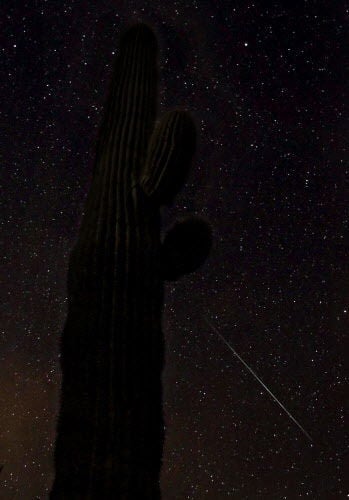Your holiday lights might be something to brag about, but look up Thursday night for another kind of light show.
The Geminid meteor shower peaks Thursday night, and Southern Arizona will have the best seats in the house. Expect clear skies and above-freezing temperatures Thursday night into Friday morning while much of the rest of the country is blanketed by clouds and snow.
As usual, this is the most active meteor shower of the year. Experts expect up to 120 meteors per hour.
“Shooting stars” will seem to radiate from the constellation Gemini, which is to the north of Orion (famous for his belt), but meteorites can be seen anywhere in the sky, said Jim Knoll, star party manager for the Tucson Amateur Astronomy Association.
The best time to view the blazing space dust and pebbles as they streak across the sky is after the moon sets at 11:08 p.m., Knoll said, but they can also be seen earlier. Keep your back to the moon and allow your eyes time to adjust to the dark for at least 15 minutes. Even peeking at your phone will wreck your night vision. You can view into the early morning hours of Friday.
Meteor showers occur when the Earth sweeps through the debris of comets.
But the Geminids are thought to originate from the 3.6-mile-wide asteroid 3200 Phaethon, which is named after the son of the sun god Helios in Greek mythology.
Helios promised to allow his son Phaethon to drive the chariot of the sun across the sky for one day. The looping path of 3200 Phaethon brings it very close to the sun — within the orbit of the innermost planet Mercury — every 1.4 years.
At this distance, Phaethon heats to over 1,200 degrees Fahrenheit, a temperature at which some rock and metals melt, creating a tail of rock chunks and grains in its wake.
The asteroid is sometimes referred to as a “rock comet” because of this comet-like behavior. But whether it is officially a comet or asteroid is still debated, Knoll said.
NASA also speculates that some of the Geminids could have originated from the remnants of a past collision, shattering bits of the asteroid.
Phaethon is the second-largest “potentially hazardous object,” according to NASA. It was discovered in October 1983. The Japanese space agency, JAXA, is planning a flyby mission called Destiny Plus to collect dust from Phaeton within the next decade.
The Geminid meteor shower has been recorded since the 1800s, and it seems to be getting more active with each passing year.
Next year’s display will be out-shined by a full moon and viewing conditions won’t be optimal again until 2020.
So bundle up, head out and look up Thursday night.





